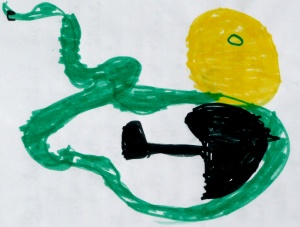 We really don’t do our kids homework for them, but we do generally try to be sounding boards and impromptu teachers when they need, and we are able—and this usually distills down to sitting with them as they re-confront the question at hand and try to puzzle through (and how quickly they get to things we’ve either entirely forgotten or never knew in the first place).
We really don’t do our kids homework for them, but we do generally try to be sounding boards and impromptu teachers when they need, and we are able—and this usually distills down to sitting with them as they re-confront the question at hand and try to puzzle through (and how quickly they get to things we’ve either entirely forgotten or never knew in the first place).
Recently my twelve-year-old, who was studying Buddhism that week, had an assignment that perplexed him. He was to find a quiet place, read a “koan” or paradoxical Zen short story, and then contemplate a series of seemingly nonsensical questions. He had done the steps, but had no idea how to answer the nonsensical questions.
I’ll share the koan first:
Tanzan and Ekido, two monks are walking through a city. They come upon a girl dressed in fine silks who cannot cross a patch of mud. Tanzan picks the girl up and carries her across the muck.
The two monks walk in silence the rest of the day, but at the monastery Ekido can no longer contain himself and bursts out, “How could you carry that girl when we are monks who shouldn’t be touching women?”
Tanzan laughs and says, “I put that girl down back in the town, it’s you who’s been carrying her all day.”
*
The questions: What color is this koan? What is the sound of this koan? What is the meaning of this koan? How much did your monkey mind wander while reading this koan.
My son was supposed to then write 300 words in answer to these questions.
Now if you’re anything like me, you can both recall that in 7th grade this would have been both difficult and tiresome, while in mid-life it is bordering on delightful.
Once encouraged to relax and think freely, my kid decided that this koan was pink, because the girl in silks was a girl and girls make him think of the color pink. It was also brown because of the mud. The sound, he decided, was of “uncomfortable silence” because they didn’t talk all day. He concluded that the meaning was to do what’s in your heart and let others do what’s in their heart. His monkey mind wandered a lot, he admitted, because this was a challenging assignment and he couldn’t stop thinking about the 300-word essay. He wrote his ideas but they were under 200 words, but after a long while of contemplating he came up with some more colors, sounds and meanings. He got to 309 words and felt great relief.
*
New koan: A boy sits on a couch unable to understand a koan. A parent comes and sits next to him in comfortable silence. The boy writes a 309-word essay and feels good about himself. The parent gazes at the boy and finally understands all the koans he’d never grasped.
*
So, let’s dedicate today to my not saying what we should think about, or dedicate ourselves to. It may be my nature to try and “help,” but I will help today by not helping, merely appreciating that our spirits somehow mingle in this moment… still in honor of all our collective children.
Namaste, Bruce



{ 3 comments… read them below or add one }
Here, here! (or should I say Hear, Hear!?)
I am right there on the couch beside you.
Welcome, welcome and thanks for trusting the spirits ability to travel—namaste!
Happily traveling.
krk